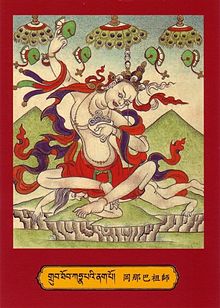This article needs additional citations for verification. (April 2021) |
This article should specify the language of its non-English content, using {{lang}}, {{transliteration}} for transliterated languages, and {{IPA}} for phonetic transcriptions, with an appropriate ISO 639 code. Wikipedia's multilingual support templates may also be used. (March 2021) |
Kānhapā, Kanha or Kanhapada or Krishnacharya[1] ( c 10th century AD) was one of the main poets of Charyapada, the earliest known example of Assamese, Bengali, Maithili, Bhojpuri, and Odia literature. He was a tantric Buddhist and a disciplle of Jalandhar. Kanhapada is also a prominent siddhacharya to Nath Sampradaya after Matsyendranatha and Gorakhnath.[2] His poems in Charjyapad are written in a code, whereby every poem has a descriptive or narrative surface meaning but also encodes tantric Buddhist teachings. Some experts believe this was to conceal sacred knowledge from the uninitiated, while others hold that it was to avoid religious persecution.
Kānhapā | |
|---|---|
 Kanhapa, 8th centurt Buddhist Mahasiddha | |
| Personal | |
| Born | c. 10th century AD |
| Religion | Tantric Buddhism |
| Senior posting | |
| Guru | Jalandhar |
Disciples
| |
| Literary works | Charyapada |
In one of his poems, Kanhupa wrote:
Your hut stands outside the city
Oh, untouchable maid
The bald Brahmin passes sneaking close by
Oh, my maid, I would make you my companion
Kanha is the kapali, a yogi
He is naked and has no disgust
There is a lotus with sixty-four petals
Upon that the maid will climb with this poor self and dance.
The language of Kanhupa's poetry bears a very strong resemblance to modern Bangla and Odia. For example,
ekaso padamA chausaTThi pAkhuRi
tahin chaRhi nAchai Dombi bApuRi
ଏକ ସୋ ପଦମା ଚଉଷଟ୍ଠୀ ପାଖୁଡ଼ି । ତହିଁ ଚଡ଼ି ନାଚଇ ଡୋମ୍ବି ବାପୁଡ଼ି ॥
এক সো পদমা চৌষট্ঠী পাখুড়ি । তহিঁ চড়ি নাচই ডোম্বি বাপুড়ি ॥
Padama (Padma:Lotus), Chausatthi (64), Pakhudi (petals) Tahin (there, in that), Charhi (climb/rise), nachai (dances), Dombi (a Bengali or Odia woman belonging to the scheduled caste, Domi/Domni), Bapuri (a Bangla and Odia word for 'poor fellow'; ‘বাপুর, বাপুড়া’[4])
Somewhat modern poetic Bangla would be, “একশো পদ্মে/পদমে চৌষট্টি পাকড়ি/পাখুড়ি। তাহে চড়িয়া/চড়ি নাচে ডোমি বাপুড়ি/বেচারি॥”
or
hA lo Dombi, to puchhami sadbhAbe.
Aisasi jAsi dombi kAhari nAbeM.
ହା ଲୋ ଡୋମ୍ବି ତୋ ପୁଛମି ସଦଭାବେ। ଆଇସସି ଜାସି ଡୋମ୍ବି କାହରି ନାବେଁ॥
হা লো ডোম্বি তো পুছমি সদভাবে। আইসসি যাসি ডোম্বি কাহরি নাবেঁ॥
The above verse hardly requires any translation to be understood in present-day Bengali or Odia.
Modern poetic Bengali version of it will be “হ্যাঁ লো ডোমনি/ডোমি, তোকে/তোয় পুঁছি/জিজ্ঞাসি/শুধাই সদ্ভাবে। আসিস-যাস ডোমি/ডোমনি কাহারে নায়/নাওয়ে”.
References edit
- ^ "Kahnapa - Banglapedia". en.banglapedia.org. Retrieved 19 January 2022.
- ^ asf. Bangalir Itihas Adiparba By Niharranjan Roy. p. 601.
- ^ "নগর বাহিরি রে ডোম্বি তোহোরি কুড়িআ". onushilon.org. Archived from the original on 20 September 2022. Retrieved 19 April 2022.
- ^ Dasa, Jnanendramohana (1937). "Bangala Bhashara abhidana". dsal.uchicago.edu. Retrieved 19 April 2022.
- ^ "নগর বাহিরি রে ডোম্বি তোহোরি কুড়িআ". onushilon.org. Archived from the original on 20 September 2022. Retrieved 19 April 2022.